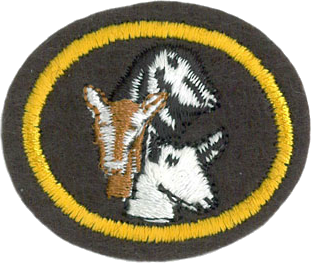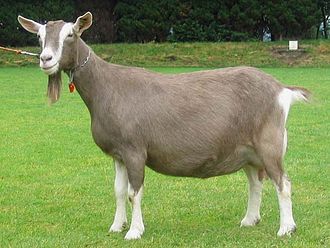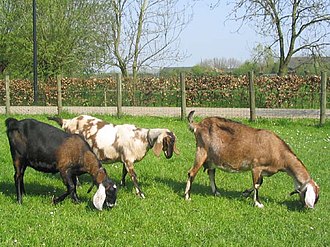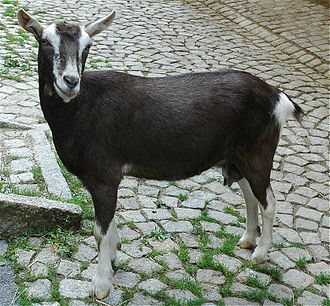Difference between revisions of "AY Honors/Goat Husbandry/Answer Key/es"
(Created page with "</noinclude> <!-- 6. 0¿Cuándo las crías machos deben ser retirados de las hembras? -->") |
|||
| (31 intermediate revisions by 2 users not shown) | |||
| Line 1: | Line 1: | ||
| − | + | {{HonorSubpage}} | |
| − | |||
| − | {{ | ||
| − | |||
| − | |||
| − | |||
| − | |||
| − | |||
| − | |||
| − | |||
| − | }} | ||
| − | |||
| − | |||
| − | |||
<section begin="Body" /> | <section begin="Body" /> | ||
{{ansreq|page={{#titleparts:{{PAGENAME}}|2|1}}|num=1}} | {{ansreq|page={{#titleparts:{{PAGENAME}}|2|1}}|num=1}} | ||
| Line 18: | Line 5: | ||
<!-- 1. Identificar vivos o a través de imágenes al menos dos razas de cabras. Mencionar si son criados para leche, carne o lana. --> | <!-- 1. Identificar vivos o a través de imágenes al menos dos razas de cabras. Mencionar si son criados para leche, carne o lana. --> | ||
| − | {{: | + | {{:AY Honors/Goat Breeds/Saanen/es}} |
| − | {{: | + | {{:AY Honors/Goat Breeds/Toggenburg/es}} |
| − | {{: | + | {{:AY Honors/Goat Breeds/Nubian/es}} |
| − | {{: | + | {{:AY Honors/Goat Breeds/British Alpine/es}} |
{{clear}} | {{clear}} | ||
| Line 43: | Line 30: | ||
<noinclude></noinclude> | <noinclude></noinclude> | ||
{{ansreq|page={{#titleparts:{{PAGENAME}}|2|1}}|num=3a}} | {{ansreq|page={{#titleparts:{{PAGENAME}}|2|1}}|num=3a}} | ||
| − | <noinclude></noinclude> | + | <noinclude></noinclude> |
{{clear}} | {{clear}} | ||
| Line 84: | Line 71: | ||
{{ansreq|page={{#titleparts:{{PAGENAME}}|2|1}}|num=6}} | {{ansreq|page={{#titleparts:{{PAGENAME}}|2|1}}|num=6}} | ||
<noinclude></noinclude> | <noinclude></noinclude> | ||
| − | <!-- 6. | + | <!-- 6. ¿Cuándo las crías machos deben ser retirados de las hembras? --> |
<noinclude></noinclude> | <noinclude></noinclude> | ||
| Line 90: | Line 77: | ||
{{ansreq|page={{#titleparts:{{PAGENAME}}|2|1}}|num=7}} | {{ansreq|page={{#titleparts:{{PAGENAME}}|2|1}}|num=7}} | ||
<noinclude></noinclude> | <noinclude></noinclude> | ||
| − | <!-- 7. | + | <!-- 7. ¿Cómo se deben arreglar las pezuñas de las cabras? --> |
| − | |||
| − | + | {{clear}} | |
| − | + | {{clear}} | |
<noinclude></noinclude> | <noinclude></noinclude> | ||
| Line 101: | Line 87: | ||
{{ansreq|page={{#titleparts:{{PAGENAME}}|2|1}}|num=8}} | {{ansreq|page={{#titleparts:{{PAGENAME}}|2|1}}|num=8}} | ||
<noinclude></noinclude> | <noinclude></noinclude> | ||
| − | <!-- 8. | + | <!-- 8. ¿Por qué son buenas las cabras para limpiar la tierra de la maleza (pasto seco)? --> |
| − | |||
<noinclude></noinclude> | <noinclude></noinclude> | ||
| Line 108: | Line 93: | ||
{{ansreq|page={{#titleparts:{{PAGENAME}}|2|1}}|num=9}} | {{ansreq|page={{#titleparts:{{PAGENAME}}|2|1}}|num=9}} | ||
<noinclude></noinclude> | <noinclude></noinclude> | ||
| − | <!-- 9. | + | <!-- 9. Mencionar por lo menos seis artículos que son elaborados a partir de pieles de cabra. --> |
| − | |||
| − | |||
| − | |||
| − | |||
| − | |||
| − | |||
| − | |||
<noinclude></noinclude> | <noinclude></noinclude> | ||
| Line 121: | Line 99: | ||
{{ansreq|page={{#titleparts:{{PAGENAME}}|2|1}}|num=10}} | {{ansreq|page={{#titleparts:{{PAGENAME}}|2|1}}|num=10}} | ||
<noinclude></noinclude> | <noinclude></noinclude> | ||
| − | <!-- 10. | + | <!-- 10. ¿Qué son las papadas en las cabras? --> |
| − | |||
<noinclude></noinclude> | <noinclude></noinclude> | ||
| Line 128: | Line 105: | ||
{{ansreq|page={{#titleparts:{{PAGENAME}}|2|1}}|num=11}} | {{ansreq|page={{#titleparts:{{PAGENAME}}|2|1}}|num=11}} | ||
<noinclude></noinclude> | <noinclude></noinclude> | ||
| − | <!-- 11. | + | <!-- 11. Criar al menos dos cabras durante seis meses. --> |
| − | |||
| − | + | {{clear}} | |
| − | + | {{clear}} | |
<noinclude></noinclude> | <noinclude></noinclude> | ||
| Line 139: | Line 115: | ||
{{ansreq|page={{#titleparts:{{PAGENAME}}|2|1}}|num=12}} | {{ansreq|page={{#titleparts:{{PAGENAME}}|2|1}}|num=12}} | ||
<noinclude></noinclude> | <noinclude></noinclude> | ||
| − | <!-- 12. | + | <!-- 12. Si se crían cabras lecheras, responder las siguientes preguntas: --> |
<noinclude></noinclude> | <noinclude></noinclude> | ||
{{ansreq|page={{#titleparts:{{PAGENAME}}|2|1}}|num=12a}} | {{ansreq|page={{#titleparts:{{PAGENAME}}|2|1}}|num=12a}} | ||
<noinclude></noinclude> | <noinclude></noinclude> | ||
| − | |||
| − | + | {{clear}} | |
| − | + | {{clear}} | |
| − | + | {{clear}} | |
<noinclude></noinclude> | <noinclude></noinclude> | ||
{{CloseReq}} <!-- 12a --> | {{CloseReq}} <!-- 12a --> | ||
{{ansreq|page={{#titleparts:{{PAGENAME}}|2|1}}|num=12b}} <!--T:32--> | {{ansreq|page={{#titleparts:{{PAGENAME}}|2|1}}|num=12b}} <!--T:32--> | ||
| − | <noinclude></noinclude> | + | <noinclude></noinclude> |
| − | |||
| − | + | {{clear}} | |
| − | + | {{clear}} | |
<noinclude></noinclude> | <noinclude></noinclude> | ||
| Line 166: | Line 140: | ||
{{ansreq|page={{#titleparts:{{PAGENAME}}|2|1}}|num=13}} | {{ansreq|page={{#titleparts:{{PAGENAME}}|2|1}}|num=13}} | ||
<noinclude></noinclude> | <noinclude></noinclude> | ||
| − | <!-- 13. | + | <!-- 13. Si se crían cabras lecheras, hacer lo siguiente: --> |
<noinclude></noinclude> | <noinclude></noinclude> | ||
{{ansreq|page={{#titleparts:{{PAGENAME}}|2|1}}|num=13a}} | {{ansreq|page={{#titleparts:{{PAGENAME}}|2|1}}|num=13a}} | ||
<noinclude></noinclude> | <noinclude></noinclude> | ||
| − | |||
| − | + | {{clear}} | |
| − | + | {{clear}} | |
| − | + | {{clear}} | |
| − | + | {{clear}} | |
<noinclude></noinclude> | <noinclude></noinclude> | ||
| Line 184: | Line 157: | ||
{{ansreq|page={{#titleparts:{{PAGENAME}}|2|1}}|num=13b}} <!--T:40--> | {{ansreq|page={{#titleparts:{{PAGENAME}}|2|1}}|num=13b}} <!--T:40--> | ||
<noinclude></noinclude> | <noinclude></noinclude> | ||
| − | |||
| − | { | + | {{clear}} |
| − | |||
| − | |||
| − | |||
| − | |||
| − | |||
| − | |||
| − | |||
| − | |||
| − | |||
| − | |||
| − | |||
| − | |||
| − | |||
| − | |||
| − | |||
| − | |||
| − | |||
| − | |||
| − | |||
| − | |||
| − | |||
| − | |||
| − | |||
| − | |||
<noinclude></noinclude> | <noinclude></noinclude> | ||
| Line 216: | Line 164: | ||
{{CloseReq}} <!-- 13 --> | {{CloseReq}} <!-- 13 --> | ||
<noinclude></noinclude> | <noinclude></noinclude> | ||
| − | == | + | ==Referencias== |
| − | + | * Wikipedia: [[esw:Pasteurización|Pasteurización]] | |
| − | |||
| − | * Wikipedia | ||
| − | [[ | ||
<noinclude></noinclude> | <noinclude></noinclude> | ||
| − | + | {{CloseHonorPage}} | |
Latest revision as of 22:33, 14 July 2022
Nivel de destreza
2
Año
1986
Version
29.12.2025
Autoridad de aprobación
Asociación General
1
Saanen
Las cabras Saanen son una raza blanca de cabra que es la más grande de las razas lecheras. Por lo general, la hembra pesa 68 kg o más, y el macho pesa más de 91 kg. La raza Saanen también produce la mayor cantidad de leche (como raza, habrá individuos buenos y pobres en cualquier raza) y tiende a tener un menor contenido de grasa láctea, alrededor de 2.5% -3%. El temperamento de Saanen es, por regla general, tranquilo y afable; los criadores han sido conocidos por referirse a ellos como malvaviscos vivos. Las cabras Saanen son más fáciles de manejar para los niños y son populares en las clases de espectáculo debido a su naturaleza tranquila. Con pelaje blanco sólido y piel rosada, estas cabras templadas extremadamente suaves son ordeñadoras pesadas. Se originaron en Suiza.
Toggenburg
El Toggenburg lleva el nombre de la región de Suiza donde se originó la raza, el valle de Toggenburg. Los Toggenburg son de tamaño mediano, moderados en producción y tienen un contenido de grasa relativamente bajo (2-3%) en su leche. El color es sólido y varía de color café claro a chocolate oscuro sin preferencia por ningún tono. Distintas marcas blancas son las siguientes: orejas blancas con una mancha oscura en el centro; dos franjas blancas en la cara desde arriba de cada ojo hasta el hocico; patas traseras blancas desde los corvejones hasta los cascos; patas delanteras blancas desde las rodillas hacia abajo con una línea oscura (banda) debajo de la rodilla aceptable; un triángulo blanco a cada lado de la cola. En esta raza suelen estar presentes papos, pequeñas protuberancias rudimentarias de la piel ubicadas a cada lado del cuello. El Toggenburg pasó por un programa de desarrollo cuando se introdujo en Gran Bretaña: el Toggenburg británico resultante era más pesado y tenía una mejor calidad de leche. A mediados del año 2002, 4146 Toggenburgs habían sido registrados en la Asociación de Criadores de Cabras Lecheras de Nueva Zelanda, lo que representa el 8.10% de las cabras lecheras registradas. Funcionan mejor en condiciones más frías. Son la raza láctea más antigua conocida de cabras.
Nubia
El Anglo-Nubia, o simplemente Nubia en los Estados Unidos, es una raza de cabra doméstica desarrollada en Gran Bretaña de ordeño nativo y cabras de Medio Oriente y el Norte de África. Sus características distintivas incluyen orejas grandes y colgantes. Debido a su herencia del Medio Oriente, las anglo-nubias pueden vivir en climas muy cálidos y tener una temporada de cría más larga que otras cabras lecheras. Considerada una raza lechera o de doble propósito, las anglo-nubias son conocidas por el alto contenido de grasa de la leche, aunque en promedio, la raza produce menos volumen de leche que otras razas lecheras. Las anglo-nubias son grandes, y pesan alrededor de 64 kg. La altura promedio de la raza, medida a la cruz, es de 81 cm para las hembras y de 94 cm para los machos. Al igual que la mayoría de las cabras lecheras, normalmente se mantienen sin cuernos mediante el desbrote dentro de aproximadamente dos semanas después del nacimiento.
Alpina británica
La alpina es una raza grande de cabra lechera que puede tener una variedad de colores de pelaje. Las alpinas británicas son negras con marcas blancas. Son las más adecuadas para climas templados y no les va bien en ambientes húmedos. Las alpinas tienen orejas erguidas, y los colores de múltiples capas son aceptables. Las alpinas son excelentes ordeñadores y pueden producir leche durante un período prolongado de tiempo. La alpina es la segunda más registrada de las razas lecheras. El contenido promedio de grasa en la leche para las alpinas fue del 3.5 por ciento en 2003 y la producción promedio de leche por hembra fue de 2.083 libras, de acuerdo con las estadísticas nacionales de Mejora del Hato Lechero.
2
3
3a
3b
3c
3d
3e
4
5
6
7
8
9
10
11
12
12a
12b
13
13a
13b
Referencias
- Wikipedia: Pasteurización






